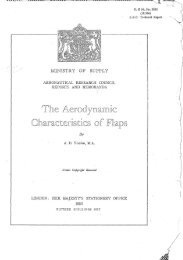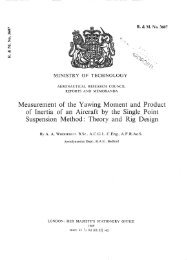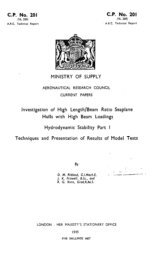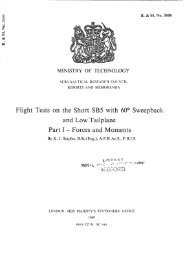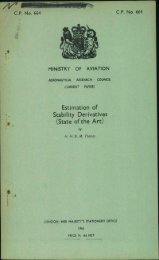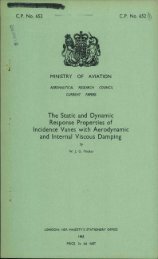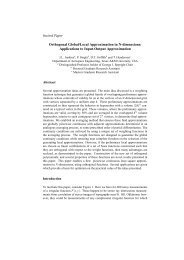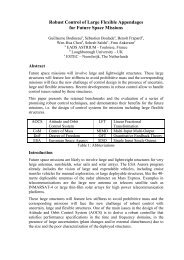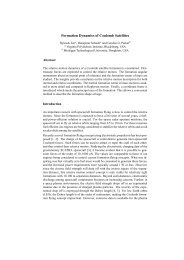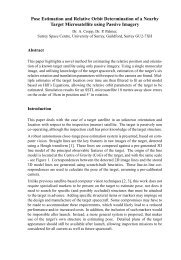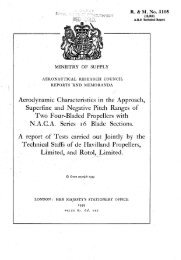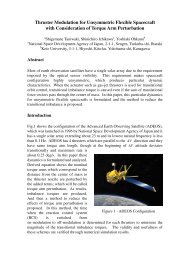A Survey of Unsteady Hypersonic Flow Problems
A Survey of Unsteady Hypersonic Flow Problems
A Survey of Unsteady Hypersonic Flow Problems
You also want an ePaper? Increase the reach of your titles
YUMPU automatically turns print PDFs into web optimized ePapers that Google loves.
- 51 -<br />
plotted together only for convenience; strictly, the results <strong>of</strong> Young are not<br />
comparable with those <strong>of</strong> Hanson since Young's measurements were made on a rnng<br />
<strong>of</strong> aspect ratio 2.9 with pitching and plunging freedoms, whereas Hanson's<br />
measurements were on a wing <strong>of</strong> aspect ratio 1-O with pitching and. flapping<br />
freedoms, and parameters like frequency ratio and axis position were significantly<br />
different for the two sets.<br />
Runysn and Morgan58 Gve . experimental evidence <strong>of</strong> the inadequacy <strong>of</strong><br />
linear theory In results for the flutter <strong>of</strong> a double-wedge wing and a thin plate<br />
wing with root flexibility. The results are given in Fig. 43. They show<br />
clearly that three-dimensional linear theory, whxch takes account <strong>of</strong> tip effects,<br />
is quite inadequate to predxt the experimental results.<br />
All <strong>of</strong> these results show the destabilising effect <strong>of</strong> increaslng<br />
thickness for particular conditions. Chawla's analysis suggested a general<br />
relationship between flutter speed, Mach number, and thickness since the result<br />
<strong>of</strong> his analysis using pxton theory showed that, If other parameters in the<br />
problem were the same, the flutter speed depended dzrectly on the product M6.<br />
ted experimentally for M > 2 by the results<br />
~t~no~~~~~~~~5~nr;eG~~~pS.<br />
The models in these tests were constructed so<br />
that they mere identical 111 mass and mass distribution. and in axis position;<br />
Vf<br />
7<br />
only the wedge thickness varies. In Fig. 44 the parameter - - is<br />
bw 4 CrM<br />
plotted against MS. Since Chawla has shown that Vf 13 prop%rtlonal to 43,<br />
the effect <strong>of</strong> this variable should be eliminated from the flutter speed parameter<br />
used. It can be seen that the results do collapse quite well on to a single<br />
curve, confirming the slgnlficance <strong>of</strong> both parameters MS and $d.<br />
(iii) Incidence<br />
Chawla56 investigates theoretically the effect <strong>of</strong> the incidence<br />
parameter Ma, on flutter <strong>of</strong> a double-wedge section. Sene results are given<br />
in Fig. 45. Under the conditions given m the figure, Pnth M6 = O-25, an<br />
Initial angle <strong>of</strong> attack giving Ma, = O-25 has a small stabxlxlng effect for<br />
0 < wh/aa < I.0 and a small destabilising effect for &I& > 1.0. For a zero<br />
thickness aer<strong>of</strong>oil, Chawla found that an initxal angle <strong>of</strong> attack reduces the<br />
flutter speed by a constant amount: for Ma, = O-25 the multiplying factor<br />
IS 0.982.<br />
Zartarian and Hsu 26 investigate theoretxally the effect <strong>of</strong> initial<br />
incidence at considerably greater values <strong>of</strong> Ma3 for a wing with 6 = O-05.<br />
The result is shown in Fig. 46. Up to Mu, = O-25, the value <strong>of</strong> the flutter<br />
velocity parameter is reduced by a factor <strong>of</strong> about O-99; for Ma, = O-50, whxh<br />
represents only a moderate incdence even at M = 5, there is a reduction by a<br />
factor <strong>of</strong> O-95.<br />
These results receive confxmation from the experimental inVeStig*tion<br />
<strong>of</strong> Young6' from which Fig. 47 is reproduced. Both theory and experiment show a<br />
decrease i: the flutter speed parameter with lncdence and show agreement on<br />
the amount. The results indicate some effect <strong>of</strong> thickness: for Ma9 = 0.10 and<br />
M6 = 1.1, the theoretical reduction factor is about O-93; for Ma, = 0'10 and<br />
M6 = l-5, the factor is O-95.<br />
The good agreement on the effect <strong>of</strong> incidence on flutter Sped between<br />
theory sd experiment in Ref. 61, is not repeated for the effect on flutter<br />
frequency./



